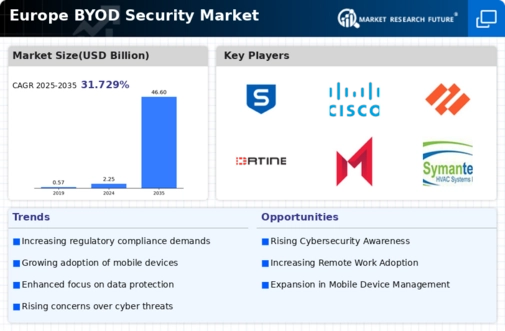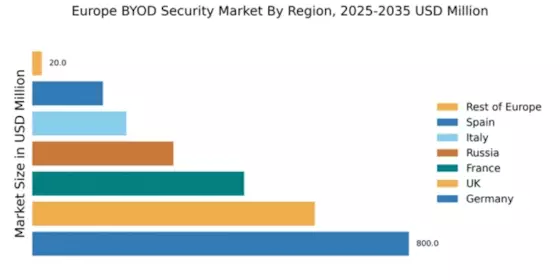Rising Cybersecurity Threats
The byod security market in Europe is increasingly driven by the rising threats posed by cybercriminals. As organizations adopt BYOD policies, the attack surface expands, making devices more vulnerable to breaches. In 2025, it is estimated that cyberattacks could cost European businesses upwards of €200 billion annually. This alarming trend compels companies to invest in robust security solutions to protect sensitive data accessed through personal devices. The urgency to safeguard corporate information from unauthorized access and data leaks is paramount, leading to a surge in demand for advanced security measures. Consequently, the byod security market is witnessing a significant uptick in the adoption of endpoint security solutions, mobile device management, and encryption technologies to mitigate these risks.
Increased Remote Work Adoption
The shift towards remote work has profoundly impacted the byod security market in Europe. As organizations embrace flexible work arrangements, employees increasingly utilize personal devices for work-related tasks. This trend has led to a notable increase in the number of devices accessing corporate networks, which, according to recent estimates, could reach over 1 billion by 2026 in Europe alone. The need to secure these devices and the data they handle has become critical. Organizations are now prioritizing the implementation of comprehensive security policies and solutions to ensure that remote access does not compromise data integrity. This evolving landscape is driving growth in the byod security market, as businesses seek to protect their assets while accommodating the changing work environment.
Growing Awareness of Data Privacy
In recent years, there has been a marked increase in awareness regarding data privacy among consumers and businesses alike in Europe. The introduction of stringent regulations, such as the General Data Protection Regulation (GDPR), has heightened the focus on data protection. Organizations are now more cognizant of their responsibilities to safeguard personal information accessed through BYOD devices. This heightened awareness is driving the demand for solutions that ensure compliance with data protection laws. The byod security market is responding to this demand by offering advanced security solutions that not only protect data but also facilitate compliance with regulatory requirements. As a result, businesses are investing in technologies that enhance data privacy and security, thereby propelling market growth.
Demand for Seamless User Experience
The byod security market in Europe is also driven by the growing demand for a seamless user experience. As employees utilize personal devices for work, they expect security measures to be unobtrusive and user-friendly. Organizations are increasingly recognizing that overly complex security protocols can hinder productivity and employee satisfaction. Therefore, there is a push towards implementing solutions that balance security with usability. This trend is leading to the development of intuitive security applications and policies that do not compromise on protection while ensuring ease of use. The byod security market is adapting to this demand by focusing on user-centric designs and solutions that enhance both security and user experience, ultimately fostering a more secure and efficient work environment.
Technological Advancements in Security Solutions
The byod security market in Europe is significantly influenced by rapid technological advancements in security solutions. Innovations such as artificial intelligence (AI), machine learning (ML), and behavioral analytics are transforming the way organizations approach security. These technologies enable proactive threat detection and response, which is crucial in an era where cyber threats are becoming increasingly sophisticated. In 2025, it is projected that the market for AI-driven security solutions could reach €10 billion in Europe. This growth indicates a strong trend towards integrating advanced technologies into security frameworks, thereby enhancing the overall security posture of organizations. The byod security market is thus evolving to incorporate these cutting-edge solutions, ensuring that businesses can effectively combat emerging threats.


















Leave a Comment